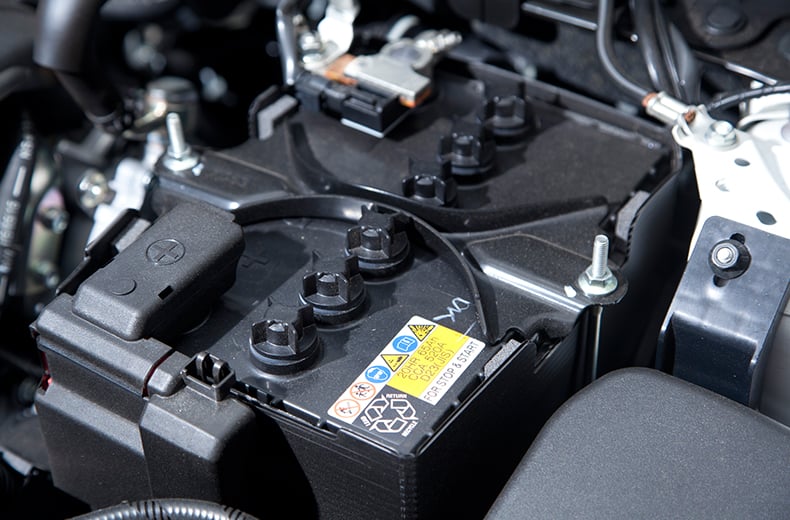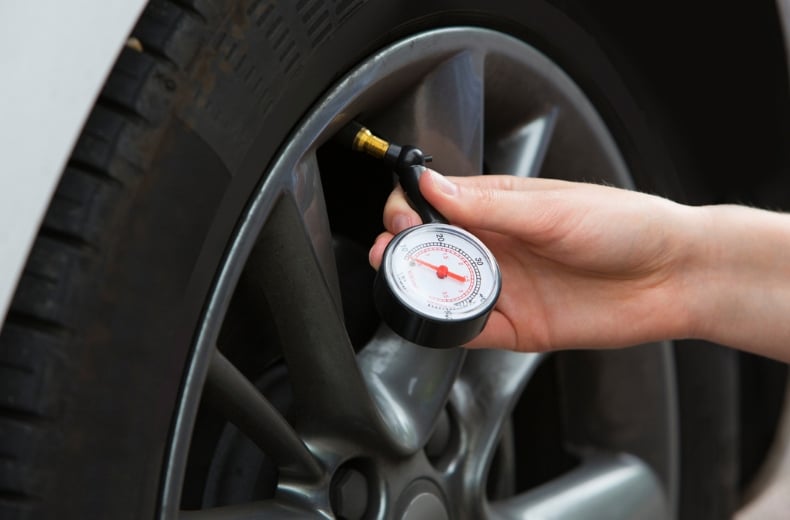If you are struggling with car maintenance - contact your local mobile mechanic.
Car batteries - how to keep yours healthy

RAC patrols deal with a lot of home flat battery breakdowns across the UK.
Without being used regularly, car batteries can lose charge meaning they may not have enough power to start the engine – this is likely to be the case if your recent journeys have been short.
This is also more likely to be the case for cars with older, weaker batteries, but even newer or brand-new batteries can fail if they haven’t been used for long periods.
Watch RAC patrol Ben Aldous show you how to look after your car battery.
Why might my battery not start my car?
The optimum voltage for a car battery is around 12.6 volts – that’s the sign of a fully-charged battery. Yet strangely, a voltage of 11.9 volts indicates a battery is completely depleted and probably doesn’t have the power to start a car.
If a battery – new or old – falls below 11 volts as a result of not being driven or independently charged for a long period it starts to suffer internal damage, meaning it may not be possible to bring it back to life.
Of course, you’re unlikely to know the exact charge in your car’s battery, but there’s likely to be three main reasons why your battery isn’t starting your car:
- The battery might be old and no longer holding its charge that well
- The car has only been used occasionally for very short runs – as has probably been the case for many people having to spend more time at home – so the battery hasn’t had a chance to charge
- The battery has been drained – this could happen because accessories like dash cams have been left plugged in, or perhaps while washing your car you’ve had the radio and interior lights on. While even immobilisers draw some charge from a battery, the important thing to remember here is that any extra drain reduces the chances of your battery starting your car when you need it to, so always disconnect everything you can if it’s not going to be driven for a long period. For the time being, it might be best to unplug your accessories.
Read more about what to do if you have a flat battery and how to tell you have one.
Using a trickle charger or battery conditioner
To reduce the chances of your battery failing you, especially if you have been driving less often, you should consider using a ‘trickle’ charger or battery conditioner.
This is the most effective way keep your battery healthy for long periods with little or no use. It will also keep immobilisers and other energy-sapping components from draining your battery completely.
Just keep in mind that using these devices could be impractical if your car is parked on the street as you may need to drape cables across the pavement, which can become a tripping hazard for passers-by.
When charging your battery always refer to your manufacturer’s handbook and follow the instructions provided with the charger.
Just starting your car may do more harm than good
If you can’t use a trickle charger the best advice is to rely on driving to keep your battery healthy.
Simply starting a car occasionally and leaving it running for only a few minutes isn’t likely to help, in fact this may end up draining a weak battery. Driving the vehicle at 50mph or more for 20-30 minutes would, in most cases, be sufficient to top up the battery charge.
If there are two cars in your household you may want to consider alternating your trips in them. You should also be mindful that repeated short journeys will flatten your battery faster than usual.
Electric vehicles and plug-in hybrids
EVs and PHEVs still rely on a 12-volt auxiliary battery to power systems which means they can go flat just like a conventional car when unused for a period of time.
The best way of maintaining the health of an EV’s 12v battery will vary from manufacturer to manufacturer, but may include putting the vehicle in ‘ready mode’ for a certain period of time every few weeks to recharge it. Check your vehicle’s manual to find out what’s recommended.
The main high voltage battery should not be left on charge permanently. It is generally recommended these should be maintained at around 50% charge but not allowed to drop below 30% if the vehicle is not in regular use.
Do I need a new battery?
If your battery’s reached the end of its life and you need to buy a new one, always make sure you choose one that meets or exceeds the specification for your vehicle.
One of the tests carried out by manufacturers is to ensure batteries have enough storage capacity to be able to start a car which hasn’t been used for a number of weeks.
But it’s important to note this test doesn’t take account of extra plugged in devices, like a dash cam, that might drain a battery and affect its ability to start a car.
Even brand-new batteries can have difficulty starting a car if they’ve not been charged up and discharged several times.
This is because most new batteries don’t leave the factory fully charged – they only reach their full charging potential by being driven regularly.
My battery is flat and my car won’t start. What can I do?
If you have another car with a charged battery parked close by the one with the failed battery, jump-starting is an option for you:
We stock a range of charging and boosting equipment in the RAC Shop. Just be sure to take the car that you’ve jump-started immediately out for a decent run of at least 20-30 minutes to charge its battery back up again.
If jump-starting isn’t an option for you or you’re still having trouble, it’s time to contact us for assistance.

Cheaper than AA or we’ll beat by 20%^
• Roadside cover from £5.49 a month*
• We get to most breakdowns in 60 mins or less
• Our patrols fix 4/5 breakdowns on the spot

Tyres

It’s crucial you check both the condition and the pressure of your tyres before any journey. Look for any cracking in the sidewalls of all your tyres – any visible damage might mean you need to change it.
If you have a spare in the boot, you can make use of this. If not, you can use a service such as RAC Tyres to get a new one fitted.
Then check the pressure in each of your tyres before you drive. It’s quite possible that tyres could have gone down if your car hasn’t been used.
You can check them yourself at home with a tyre pressure gauge or at your nearest filling station.
If they’ve gone down you’ll need to inflate to them to the recommended levels outlined in your vehicle handbook, which will list the required pressures based on the sort of loads you expect to be carrying. You can use your own tyre pump or use those available at petrol and service stations.
If a car is left for a long period of time this can lead to flat spots and your tyres losing their round shape, especially on older tyres.
Oil, coolant, washer fluid and lights
If you've been using your car less than usual, you should check things like oil, coolant, and whether all your lights are working properly once before you start driving a regular amount again. But make a point of doing this to reduce the chances of an unnecessary breakdown.
Top up your:
- oil, but only after safely draining used oil and its corrosive elements. Don't forget to take your car on a decent journey so that the fresh oil can circulate around the engine
- fuel, to prevent moisture from accumulating in the tank and rust developing. Adding fuel stabiliser will extend its lifespan too
- coolant
- window wash
It’s also a good idea to use your air conditioning for a few minutes whilst driving to avoid expensive component damage if there's been any period of inactivity.
Spare bulbs
You may be prosecuted if your car is deemed unsafe, which it will be if you don’t have properly working lights.
Make sure your vehicle is roadworthy by picking up spares. You may be able to find the right hardware in the RAC Shop.
Handbrake
There’s a chance the handbrake or parking brake on your car could be stuck on if not used for long periods. You can reduce the chances of this happening by occasionally letting the handbrake on and off – but make sure you only do this when the car is parked on a completely flat surface and chock two wheels if possible.
If you keep your car securely in a garage, you could choose to engage first gear (or use P for an automatic) and place chocks around the wheels to prevent any movement.
Where to park
If you’re not planning on using your car for a while you’ll need to leave it parked somewhere safe and sheltered from the elements.
A private garage is the best choice, as it could help deter would-be thieves and vandals, while also protecting your paintwork from adverse weather and other outdoor threats. You should make sure your car is dry and the garage is well ventilated too.
The secure location means you can even leave your car in gear with chocks behind the wheels instead of the handbrake to save the handbrake cable from stretching.
If a garage isn’t an option, try to park somewhere shaded during the day and well-lit at night. Trees offer protection from some types of weather but will leave your car more vulnerable to bird droppings and tree sap, which you’ll have to clean up later.
A cover will protect your car against the outside world but should only be used when it’s not obscuring a necessary parking permit.
When you’re out on the road – what to look out for
Firstly, when you start your car for the first time in a long time, it’s a good idea to let it run for a minute or so to ensure the oil has a chance to circulate properly – as it will have drained out of some areas over time.
When you’re driving, your car shouldn’t feel any different in the way it drives, except that the brakes may be noisy at first. This is normal – the discs can rust easily when left, but this quickly clears as you start using the brakes. The best advice is to apply them gently.
And whatever you do, don’t flick the windscreen wipers on if you have a dry windscreen – if there’s any grime, tree pollen or grit on the wipers then doing this risks making the glass dirty or even scratching it. Use the wipers when the windscreen is wet, for example when using washer fluid.
Finally, once you’re able to go for a drive of a decent length – ideally 20-30 minutes on a variety of roads so that you can cycle through the gears, get the engine up to its proper operating temperature and, importantly, get the battery properly recharged.
Motorbikes
Here are our tips for getting out on the road again if your motorbike has seen less use recently:
Getting help
The RAC is here for its members.
Depending on the nature of the problem with your car, we may recommend our RAC Remote Technician service that gives you the experience of an RAC patrol but without having to wait for one to arrive. Here’s how it works:
Arrange breakdown cover
Using your car infrequently could mean a problem goes unnoticed until it’s too late; arranging breakdown cover ahead of time will offer peace of mind.
Our cover also comes with home start as standard, which will make sure that a patrol will come out to you if your vehicle breaks down within a 1/4 mile of your home.
Our patrols are following government advice to keep themselves and our members safe.
If your MOT is due or if you would like to book your vehicle in for a full car service, you can book online with your local RAC Approved Garage today.
Get 30 driving tips that will save you money
Running a car isn’t cheap, but there are some easy things you can do to keep your costs down. Get these tips and more useful driving articles sent straight to your inbox now.











